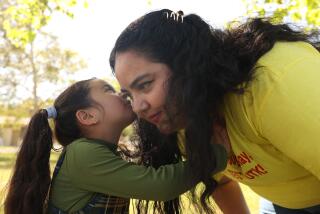A Closer Look at the Standards for Recognizing Gifted Children
- Share via
Your recent two-part article on the GATE program was excellent.
I’m a father of a seventh-grade son who takes medication for Attention Deficit Disorder and fourth-grade daughter who’s been recommended for the GATE program in one of San Clemente’s grade schools.
The truth is, he’s more gifted than she. Yet, if my wife and I hadn’t taken an intense interest in our son’s struggles, he’d probably be little more than a dropout-in-waiting. Our daughter is an exceptional student because what’s asked of a student in the typical grade school classroom fits her native intelligence perfectly: She completes work on time and (does it) very carefully; she memorizes spelling words to perfection; she’s helpful to the teacher and the other students; she’s socially skilled and always cheerful. She’s the classic “teacher’s pet.” Is she gifted? I’m not so sure. Given an assignment that follows a linear path to completion, she’s a star. Her extrinsic motivation to please others drives her to employ her natural talent. Given an open-ended assignment, which requires an intrinsic motivation, and she’s not such a star.
Our son is just the opposite. For him to follow a linear path to a completed assignment, for a grade and for the teacher’s approval, perplexes and frustrates him. Yet, he desperately wants the teachers’ approval and he knows a “good” grade will win approval at home. If you’d watch him “play” at home, you’d say, “This kid’s going to be another Steven Spielberg or David Copperfield.” If you see his progress reports from school, you’d say this kid’s headed for a life of frustrating, non-productive underachievement.
I’m an ADD adult who’s enjoyed modest success as an advertising writer, photographer and producer. I say modest because the business world shares the teaching profession’s obsession with analytical and sequential thinking skills. However, I teach creative photography to a worldwide organization of highly successful business leaders called the Young Presidents’ Organization.
These individuals relish the challenge of using the visual, spatial parts of their brain in an environment where they are driven completely by whatever intrinsic motivation they can muster. It’s a kind of GATE program in reverse. They learn how and why to create an environment within their companies where non-sequential and non-analytical thinkers can make important contributions. So everybody can be a star.
The GATE program must not be held out as something for special kids. What we as parents and educators are learning is that all kids have special talents. And if we don’t do everything possible to spot those talents and help kids gain confidence and self-esteem and to exploit these talents, we are doing a terrible injustice to a large percentage of our school kids.
ANDY FULTON
San Clemente
More to Read
Sign up for Essential California
The most important California stories and recommendations in your inbox every morning.
You may occasionally receive promotional content from the Los Angeles Times.













